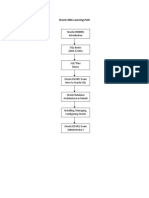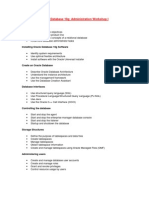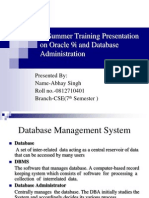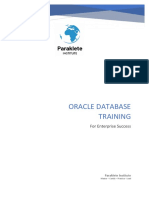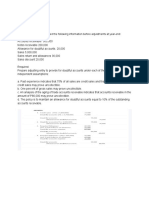0 ratings0% found this document useful (0 votes)
242 viewsExploring The Oracle Database Architecture
This document provides an overview of the topics covered in the Oracle Database 11g: SQL Fundamentals and Oracle Database 11g: Administration courses. The courses cover SQL and PL/SQL, database administration, security, backup and recovery, and performance tuning. Specific topics include SQL functions, joins, subqueries, data manipulation, schema objects, user access control, storage structures, auditing, maintenance, and backup solutions. The goal is to teach students to write SQL, administer an Oracle database, and perform backup and recovery tasks.
Uploaded by
Thuan DangCopyright
© © All Rights Reserved
We take content rights seriously. If you suspect this is your content, claim it here.
Available Formats
Download as DOCX, PDF, TXT or read online on Scribd
0 ratings0% found this document useful (0 votes)
242 viewsExploring The Oracle Database Architecture
This document provides an overview of the topics covered in the Oracle Database 11g: SQL Fundamentals and Oracle Database 11g: Administration courses. The courses cover SQL and PL/SQL, database administration, security, backup and recovery, and performance tuning. Specific topics include SQL functions, joins, subqueries, data manipulation, schema objects, user access control, storage structures, auditing, maintenance, and backup solutions. The goal is to teach students to write SQL, administer an Oracle database, and perform backup and recovery tasks.
Uploaded by
Thuan DangCopyright
© © All Rights Reserved
We take content rights seriously. If you suspect this is your content, claim it here.
Available Formats
Download as DOCX, PDF, TXT or read online on Scribd
You are on page 1/ 5
Oracle Database 11g: SQL Fundamentals
Using Conversion Functions and Conditional Expressions
Describe various types of conversion functions that are available in SQL
Use the TO_CHAR, TO_NUMBER, and TO_DATE conversion functions
Apply conditional expressions in a SELECT statement
Displaying Data from Multiple Tables
Write SELECT statements to access data from more than one table using
equijoins and nonequijoins
Join a table to itself by using a self-join
View data that generally does not meet a join condition by using outer joins
Generate a Cartesian product of all rows from two or more tables
Using Subqueries to Solve Queries
Define subqueries
Describe the types of problems that the subqueries can solve
List the types of subqueries
Write single-row and multiple-row subqueries
Using the Set Operators
Describe set operators
Use a set operator to combine multiple queries into a single query
Control the order of rows returned
Manipulating Data
Describe each data manipulation language (DML) statement
Insert rows into a table
Update rows in a table
Delete rows from a table
Control transactions
Using DDL Statements to Create and Manage Tables
Categorize the main database objects
Review the table structure
List the data types that are available for columns
Create a simple table
Explain how constraints are created at the time of table creation
Describe how schema objects work
Creating Other Schema Objects
Create simple and complex views
Retrieve data from views
Create, maintain, and use sequences
Create and maintain indexes
Create private and public synonyms
Oracle Database 11g: Controlling User Access and Managing Schema
Objects
Controlling User Access
Managing Schema Objects
Oracle Database 11g: Data Dictionary Views and Large Data Sets
Managing Objects with Data Dictionary Views
Manipulating Large Data Sets
Oracle Database 11g: Administration
Workshop
Exploring the Oracle Database Architecture
Oracle Database Architecture Overview
Oracle ASM Architecture Overview
Process Architecture
Memory structrues
Logical and physical storage structures
ASM storage components
Installing your Oracle Software
Tasks of an Oracle Database Administrator
Tools Used to Administer an Oracle Database
Installation: System Requirements
Oracle Universal Installer (OUI)
Installing Oracle Grid Infrastructure
Installing Oracle Database Software
Silent Install
Creating an Oracle Database
Planning the Database
Using the DBCA to Create a Database
Password Management
Creating a Database Design Template
Using the DBCA to Delete a Database
Managing the Oracle Database Instance
Start and stop the Oracle database and components
Use Oracle Enterprise Manager
Access a database with SQLPlus
Modify database installation parameters
Describe the stages of database startup
Describe database shutdown options
View the alert log
Access dynamic performance views
Manage the ASM Instance
Set up initialization parameter files for ASM instance
Start up and shut down ASM instances
Administer ASM disk groups
Configuring the Oracle Network Environment
Use Enterprise Manager to create and configure the Listener
Enable Oracle Restart to monitor the listener
Use tnsping to test Oracle Net connectivity
Identify when to use shared servers and when to use dedicated servers
Managing Database Storage Structures
Storage Structures
How Table Data Is Stored
Anatomy of a Database Block
Space Management in Tablespaces
Tablespaces in the Preconfigured Database
Actions with Tablespaces
Oracle Managed Files (OMF)
Administering User Security
Database User Accounts
Predefined Administrative Accounts
Benefits of Roles
Predefined Roles
Implementing Profiles
Managing Data Concurrency
Data Concurrency
Enqueue Mechanism
Resolving Lock Conflicts
Deadlocks
Managing Undo Data
Data Manipulation
Transactions and Undo Data
Undo Data Versus Redo Data
Configuring Undo Retention
Implementing Oracle Database Auditing
Describe DBA responsibilities for security
Enable standard database auditing
Specify audit options
Review audit information
Maintain the audit trail
Database Maintenance
Manage optimizer statistics
Manage the Automatic Workload Repository (AWR)
Use the Automatic Database Diagnostic Monitor (ADDM)
Describe and use the advisory framework
Set alert thresholds
Use server-generated alerts
Use automated tasks
Performance Management
Performance Monitoring
Managing Memory Components
Enabling Automatic Memory Management (AMM)
Automatic Shared Memory Advisor
Using Memory Advisors
Dynamic Performance Statistics
Troubleshooting and Tuning Views
Invalid and Unusable Objects
Backup and Recovery Concepts
Part of Your Job
Statement Failure
User Error
Understanding Instance Recovery
Phases of Instance Recovery
Using the MTTR Advisor
Media Failure
Archive Log Files
Performing Database Backups
Backup Solutions: Overview
Oracle Secure Backup
User-Managed Backup
Terminology
Recovery Manager (RMAN)
Configuring Backup Settings
Backing Up the Control File to a Trace File
Monitoring the Flash Recovery Area
Performing Database Recovery
Opening a Database
Data Recovery Advisor
Loss of a Control File
Loss of a Redo Log File
Data Recovery Advisor
Data Failures
Listing Data Failures
Data Recovery Advisor Views
Moving Data
Describe ways to move data
Create and use directory objects
Use SQL*Loader to move data
Use external tables to move data
General architecture of Oracle Data Pump
Use Data Pump export and import to move data
Using Flashback Technology I
Flashback Technology: Overview and Setup
Using Flashback Technology to Query Data
Flashback Table
Flashback Transaction Query
Performing Flashback Transaction Backout
Using Flashback Technology II
Oracle Total Recall
Flashback Drop and the Recycle Bin
You might also like
- Oracle Database 11g: SQL Fundamentals I: Exam Number: 1Z0-051 Exam Price: US$ 125No ratings yetOracle Database 11g: SQL Fundamentals I: Exam Number: 1Z0-051 Exam Price: US$ 1254 pages
- Oracle DBA 11g@Training@DBA School HyderabadNo ratings yetOracle DBA 11g@Training@DBA School Hyderabad10 pages
- Oracle Database 11g: Administration Workshop I - D50102GC11No ratings yetOracle Database 11g: Administration Workshop I - D50102GC1113 pages
- 1 Oracle Database Administration: OverviewNo ratings yet1 Oracle Database Administration: Overview5 pages
- Oracle Database 10 G: Administration Workshop I Release 2: What You Will LearnNo ratings yetOracle Database 10 G: Administration Workshop I Release 2: What You Will Learn8 pages
- Oracle Database 10g Administration Workshop II Release 2No ratings yetOracle Database 10g Administration Workshop II Release 25 pages
- Oracle Database 11g-Administration Workshop I - D50102GC10No ratings yetOracle Database 11g-Administration Workshop I - D50102GC103 pages
- Oracle Database 10g: Administration Workshop INo ratings yetOracle Database 10g: Administration Workshop I6 pages
- Oracle 11g DBA PLSQL LINUX Course ContentNo ratings yetOracle 11g DBA PLSQL LINUX Course Content12 pages
- (XXXX) Syllabus - Oracle Database 11g Administration Workshop I (1Z0-052) by Ari 050614No ratings yet(XXXX) Syllabus - Oracle Database 11g Administration Workshop I (1Z0-052) by Ari 0506141 page
- Oracle Database 19c Administration TrackNo ratings yetOracle Database 19c Administration Track7 pages
- Oracle Database: Introduction To SQL: DuraciónNo ratings yetOracle Database: Introduction To SQL: Duración5 pages
- Oracle Database 11g: New Features For Administrators: What You Will LearnNo ratings yetOracle Database 11g: New Features For Administrators: What You Will Learn6 pages
- Oracledatabase19c Administration WorkshopNo ratings yetOracledatabase19c Administration Workshop3 pages
- Total Number of Days 19: Duration: 5 Days Training + 2 Day Exam Prep + 1 Day Exam Exam Code: #1Z0-051No ratings yetTotal Number of Days 19: Duration: 5 Days Training + 2 Day Exam Prep + 1 Day Exam Exam Code: #1Z0-05110 pages
- Oracle Database: Introduction To SQL Ed 2: DurationNo ratings yetOracle Database: Introduction To SQL Ed 2: Duration5 pages
- Course Contents: Oracle 11g Structure Query Language Fundamental-L (SQL)No ratings yetCourse Contents: Oracle 11g Structure Query Language Fundamental-L (SQL)15 pages
- Exam Available Online: Oracle Certification Program Oracle Database 11g: SQL Fundamentals INo ratings yetExam Available Online: Oracle Certification Program Oracle Database 11g: SQL Fundamentals I2 pages
- Relational Database Management System (RDBMS) : PayrollNo ratings yetRelational Database Management System (RDBMS) : Payroll114 pages
- Database Management Systems Syllabus e8f0ed40 Ddbb 467d Ab10 d3d4e8995ca1No ratings yetDatabase Management Systems Syllabus e8f0ed40 Ddbb 467d Ab10 d3d4e8995ca18 pages
- Oracle Database 10g: Introduction To SQL: DurationNo ratings yetOracle Database 10g: Introduction To SQL: Duration5 pages
- Assessing The Influence of Self-Efficacy On Entrepreneurial Intentions of Social EntrepreneursNo ratings yetAssessing The Influence of Self-Efficacy On Entrepreneurial Intentions of Social Entrepreneurs76 pages
- Sap Successfactors What'S New Viewer: WarningNo ratings yetSap Successfactors What'S New Viewer: Warning3 pages
- A Study On Consumer'S Preference of Branded Shoes: Master of Business Administration100% (1)A Study On Consumer'S Preference of Branded Shoes: Master of Business Administration36 pages
- PWC - Expectations of The Fintech Industry From Union-Budget 2023-24No ratings yetPWC - Expectations of The Fintech Industry From Union-Budget 2023-2417 pages
- Dole Department Order No. 40-J, S. 2022: CD Technologies Asia, Inc. © 2022No ratings yetDole Department Order No. 40-J, S. 2022: CD Technologies Asia, Inc. © 20223 pages
- Shattoemmajo Wickedlittleteas CapstonefinalbusinesNo ratings yetShattoemmajo Wickedlittleteas Capstonefinalbusines25 pages
- Business Economics - Code - 107 (BBA-G.& BBA-B&I) - Sem. I 2100% (1)Business Economics - Code - 107 (BBA-G.& BBA-B&I) - Sem. I 2152 pages
- AH - BE - Specification of Costs For Additional Services Air Freight Export - ENNo ratings yetAH - BE - Specification of Costs For Additional Services Air Freight Export - EN2 pages
- BSA 1 13 Group 4 - Exercises 6 1 and 6 2No ratings yetBSA 1 13 Group 4 - Exercises 6 1 and 6 210 pages
- Journal of Transport Geography: SciencedirectNo ratings yetJournal of Transport Geography: Sciencedirect11 pages





